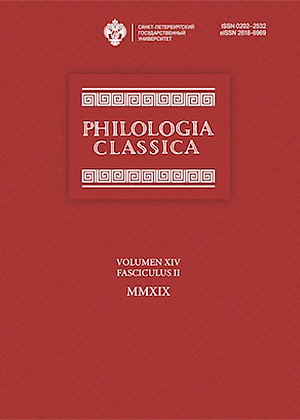Orthios as a Rhythmical Term
DOI:
https://doi.org/10.21638/11701/spbu20.2019.201Аннотация
Some ancient sources claim that the orthian nome was named so due to its rhythm. In order to estimate the probability of this assertion the author first examines known cases of ὄρθιος as a metrical or rhythmical term. After dismissing evidence which seems either mistaken or using ὄρθιος in a non-technical sense, the author believes that the following meanings are reliably attested: (1.1) an iambic trimeter with only pure iambic feet (possibly the term could be applied to other uniform verses as well); (1.2) a cretic with a resolution of both longs; (1.4) a sequence – ∪∪ – – ; (1.6) an elongated iambic foot, which consists of a tetraseme and an octaseme syllable. Next, the author analyzes what is reported concerning the rhythm of the orthian nome. As authors of the classical period, who were still able to hear the piece performed, attribute two different rhythms to it (elongated iambs and τὸ κατὰ δάκτυλον εἶδος), and also claim that Terpander used orthian rhythm to create a particular version of the orthian melody, it follows that ὄρθιος νόμος was not named πὸ τοῦ ῥυθμοῦ. In support of this conclusion, it seems clear that the orthian nome was very well known to common people in the fifth century BC, so that its name must have been understood even by those who were no experts in rhythmical theory.
Ключевые слова:
Ancient Greek music, nomes, orthios, rhytmical terms
Скачивания
Библиографические ссылки
Загрузки
Опубликован
Как цитировать
Выпуск
Раздел
Лицензия
Статьи журнала «Philologia Classica» находятся в открытом доступе и распространяются в соответствии с условиями Лицензионного Договора с Санкт-Петербургским государственным университетом, который бесплатно предоставляет авторам неограниченное распространение и самостоятельное архивирование.






